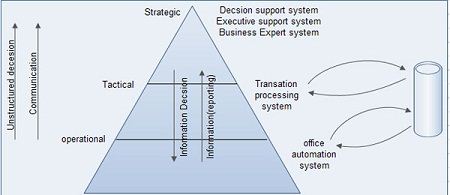Organizations use several types of information systems to suit their needs. The various types of information systems that an organization uses may be classified into the following categories:
- Office automation systems
- Transaction processing system
- Decision support systems
- Executive information systems
- Business expert system
Apart from these broad classes of information systems, organizations also use specific information systems for some special tasks like executive information system, enterprise (wide) resource planning systems, customer relationship management systems and supply chain management system. These systems also fall under the above broad classification.
We’ll be covering the following topics in this tutorial:
Office Automation Systems
This type of information system aids in automating office tasks. They have a limited role in decision-making and are more useful for operational level people. The information coming out of this kind of system can be used for rule-based decision-making for managers at the operational level. These systems however play an important role in automating several functions of an office and thus help in creating paperless offices. These kinds of systems help in increasing the productivity and efficiency of the office workforce by automating simple tasks. These systems mostly deal with operational data. More and more modern businesses are opting for this paperless office environment as this brings in the following unique advantages for the business:
- Office work becomes faster and process driven.
- All basic level data is digitized and stored for future action.
An example of office automation system is the office suite of software that helps in automating simple office tasks like presentations and documentation. Sometimes we also come across a class of systems called the operations support system (OSS). OSS also work with the lowest levl31of management is ensuring that the operations of the firm are performed smoothly. OSS can be very different from Office Automation System even though they both help bottom level managers, in term of the information complexity involved.
Transaction Processing System
This type of system is critical to the smooth functioning of an organization. The objective of this kind of system is to capture all transaction related data between the organization and its external and internal customers. Typically, these transaction level data are stored in a pre-formatted manner in a relational database for further action in future. TPS is the most widely used form of information systems as they provide the management with the flexibility of storing data in a structured manner and retrieving it at a later date using a query facility. The system also helps in aggregating and summarizing the data for creating of management reports. These reports are further improved by using visualization tools that help the management in understanding situations and scenarios better. These systems deal with tactical data from within the organization.
An example of TPS would be the sales management system with a relational database management system at the server side back end and a customized front end to interact with the users.
Decision Support Systems
Decision support systems help senior management to take strategic decisions. Contrary to the other systems, decision support systems are developed with the objective of providing the users (top management personnel) with unstructured information. These systems help the management to develop ‘what if analysis’ so that different scenarios can be developed for decision-making. Decision support systems deal with both internal and external data. Such systems are custom built with features like business dashboard and scenario panel.
Such systems are complex with working models (internal) on the data to provide the senior managers with decision support. Unlike transaction processing systems, these systems are not query dependent only. Their main role is to access data from a data repository and then pass that data through a model (mathematical, heuristic, statistical, econometric, operations research and combinatorial), so that the senior management can take better decisions by doing either ‘what if analysis’ and scenario building or by doing ‘predictive analysis’ to get some insight into a business issue. Such systems are very costly to build and require advanced analytics tools.
Executive Support System
Executive support system is also known as the executive information (support) system. It began to gain acceptance in the mid-eighties in large corporations and is now used even is smaller corporations. In functionality, it is nearer to decision support systems than management information systems. Its main objectives are to provide a macro-organization wide view for senior executives, by providing a very user-friendly user-interface so that proactive steps may be taken to beat competition. It provides timely and proactive organization tracking and control. It is able to perform these tasks by providing fast access to all type of data and by filtering and tracking critical data and information. It helps to identify problems and opportunities and thus, helps senior executives to troubleshoot problems and take advantage of opportunities.
Business Expert System
Some business scenarios are so complex that they require the help of advanced systems that can provide expert solutions. These systems use artificial intelligence and neutral networks to reach the performance level of a human expert thereby helping the organization. These systems are different from any other information system as they are capable of decision-making by themselves without human intervention. Actually, these systems are loaded with the knowledge of experts and these systems simply simulate the expert knowledge to arrive at decisions.

 Dinesh Thakur holds an B.C.A, MCDBA, MCSD certifications. Dinesh authors the hugely popular
Dinesh Thakur holds an B.C.A, MCDBA, MCSD certifications. Dinesh authors the hugely popular